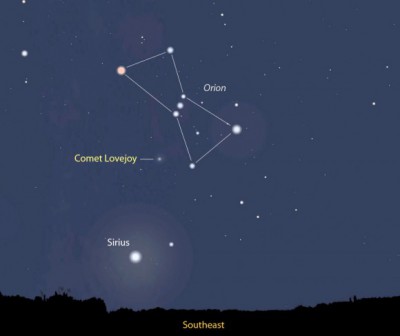This story first appeared on The Outer Banks Voice.
A green-glowing comet is very close to our planet, and Earthlings will not see it again for about 8,000 years.
Supporter Spotlight
If the clouds permit and there are not a lot of lights to the southeast, you will be able to see Comet Lovejoy (aka C/2014 Q2) with the unaided eye for a few days. And, you may be able to see it with good eyes or binoculars through Jan. 25 or so.
If you want to see Lovejoy, find the large bow tie-looking constellation, Orion, and look to the right, where Orion might want a football to be before he kicked it. The bow tie is standing almost vertically at 9 p.m., and the knot is twisted counterclockwise.

You may wonder why astronomers would spend any time studying comets or asteroids. Other than the obvious fact that such objects have caused mass extinctions and huge damage on Earth, there is another reason.If you cannot see the comet, take some binoculars and scan the area in front of Orion’s front foot (actually, it is his left foot). Once the Moon comes up, it will be significantly harder to see the dim green glow of Comet Lovejoy, but luckily the moon rises later each day. The later in the evening you can get a good look, the higher in the sky the comet will be.
First a little background. Asteroids are generally small rocky bodies that can be found between the orbits of Mars and Jupiter. Comets are like dirty snowballs that spend most of their time in the Kuiper belt — a doughnut-shaped ring whose inner edge is about as far from the Sun as Pluto’s orbit — or the Oort cloud — a spherical distribution of asteroids and comets that have been sent in large (50,000 times the distance from the Sun to the Earth), oddly oriented orbits by near collisions with Jupiter and other planets.
Meteors are what most people call shooting stars. They are usually rocky or icy objects that are about the size of a pea, and they burn up in our atmosphere. Occasionally, slightly bigger objects make it through a good part of our atmosphere and make a beautiful and scary show — they are fireballs.
Supporter Spotlight
Finally, if an object like a fireball, meteor, asteroid or comet actually hit the Earth’s surface, it becomes a meteorite.








